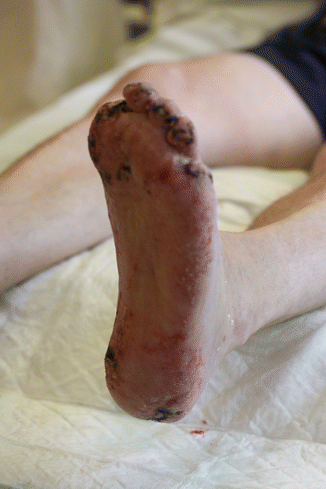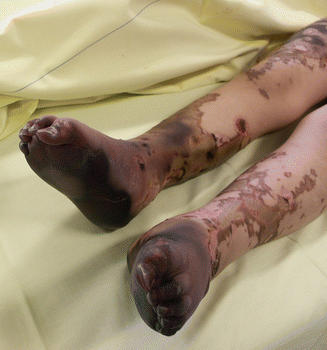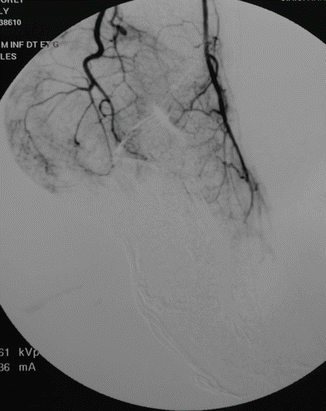Fig. 13.1
Initial state of a patient still taking vasopressive drugs

Fig. 13.2
Evolution 3 weeks after and the stopping of vasoactive drugs and amputation of the toes
13.3.2 The Strategy Concerning the Therapeutic Attitude
The therapeutic decision is complex and does not comply with the established decision tree. It mainly depends on the experience of the practitioner, but the final decision often comes from the patient himself.
We exclude the situations relying on classical techniques of healing (skin graft, treatment by negative pressure, etc.). We have limited ourselves to the most serious situations where the only solution is to perform a free flap to avoid the amputation of the leg [2]. Situations exist where all attempts at salvage are excluded due to the clinical situation: necrosis affecting the entire foot (plantar side, dorsal side, and heel cup) and especially when the necrosis reaches the proximal aspect of the ankle (Fig. 13.3), the contraindications to microsurgery (arterial patient, heart failure, renal failure…) and a patient who has no donor site (latissimus dorsi muscle). When a solution seems conceivable, the patient must be seen awake and the therapeutic stake must be clearly explained, as well as the risks of amputation, in case of failure. These patients should be in complete physiological and mental recovery, and this decision does not need to be taken urgently. It is also necessary to see the patient several times to be sure that the situation and the potential complications are completely understood. Of course, all the elements will be taken into account in the therapeutic option (age, professional activity, uni- or bilateral injury…). As in many of these difficult decision-making moments, care must be taken to avoid increasing the number of people involved as this makes the decision process more complicated for the patient. Nevertheless, we ask a rehabilitation doctor specialised in limb prostheses to visit the patient, so that the patient has a complete picture of the problems. The options can be simplified to salvage or amputation of one or more limbs or parts of the limbs. The objective is saving the foot but toes were usually not be saved. The aim is therefore to anticipate a back to normal walking. However, running will definitively be compromised.


Fig. 13.3
A young boy 6 years of age presenting with necrosis of 2 ft going up to the ankle. Surgical exploration having confirmed this extensive necrosis with notable necrosis in the two ankle bones, no solution has unfortunately been envisioned
The salvage require a microsurgical muscle transfer. Usually the latissimus dorsi muscle is used (isolated or associated with the dental muscle) to cover this large loss of substance. The choice of muscle (versus cutaneous flap) is fundamental. This choice remains controversial [3], but for us, it will be the only way to fill the dead space volume after debridement, the only way to be sufficiently thick to ensure a secondary support and avoid the soaping phenomenon, and it is the best way to reduce the risk of infection. In addition, we think that the blood reserve that represents the muscle allows debridement to be limited because certain undefined tissue limits may benefit the vascular supply brought locally by the revascularised muscle. The only negative in this strategy is the sacrifice of the latissimus dorsi muscle which may be detrimental if the intervention fails, and the use of crutches proves to be necessary.
If the decision is taken, a vascular assessment is performed in order to explore the arteries of the lower limbs. The choice of an arteriogram or an echo/Doppler with a flux calculation may be performed. The arteriogram usually shows a clear interruption of the arteries with a healthy network before and a vascular desert after (Fig. 13.4).










